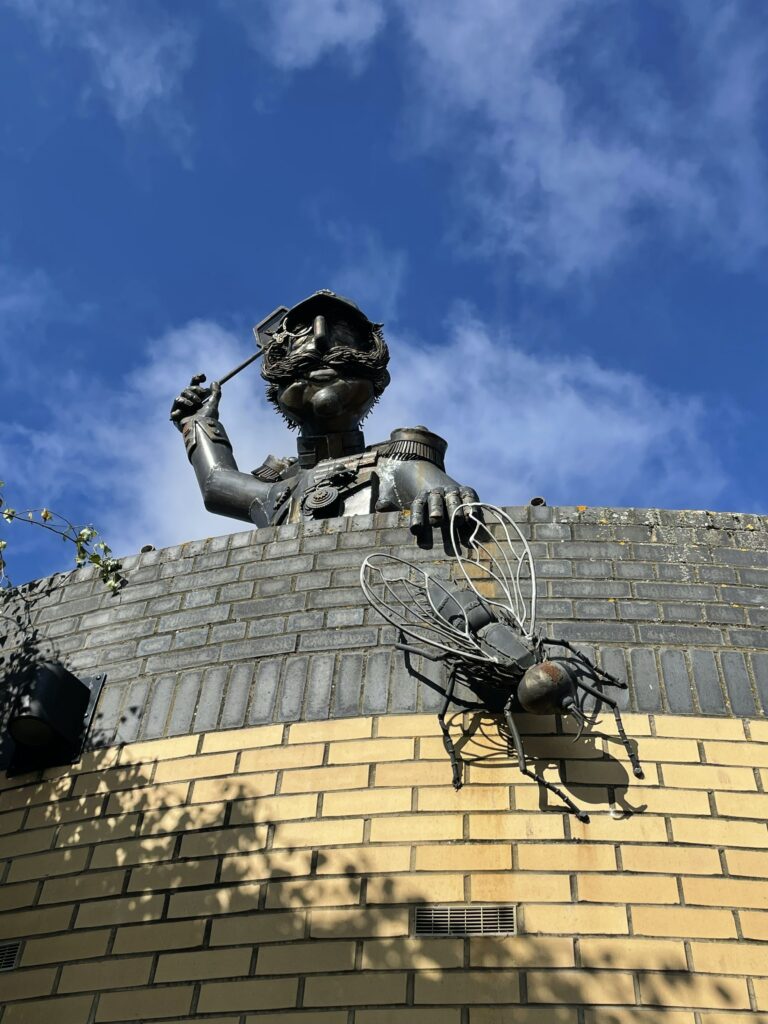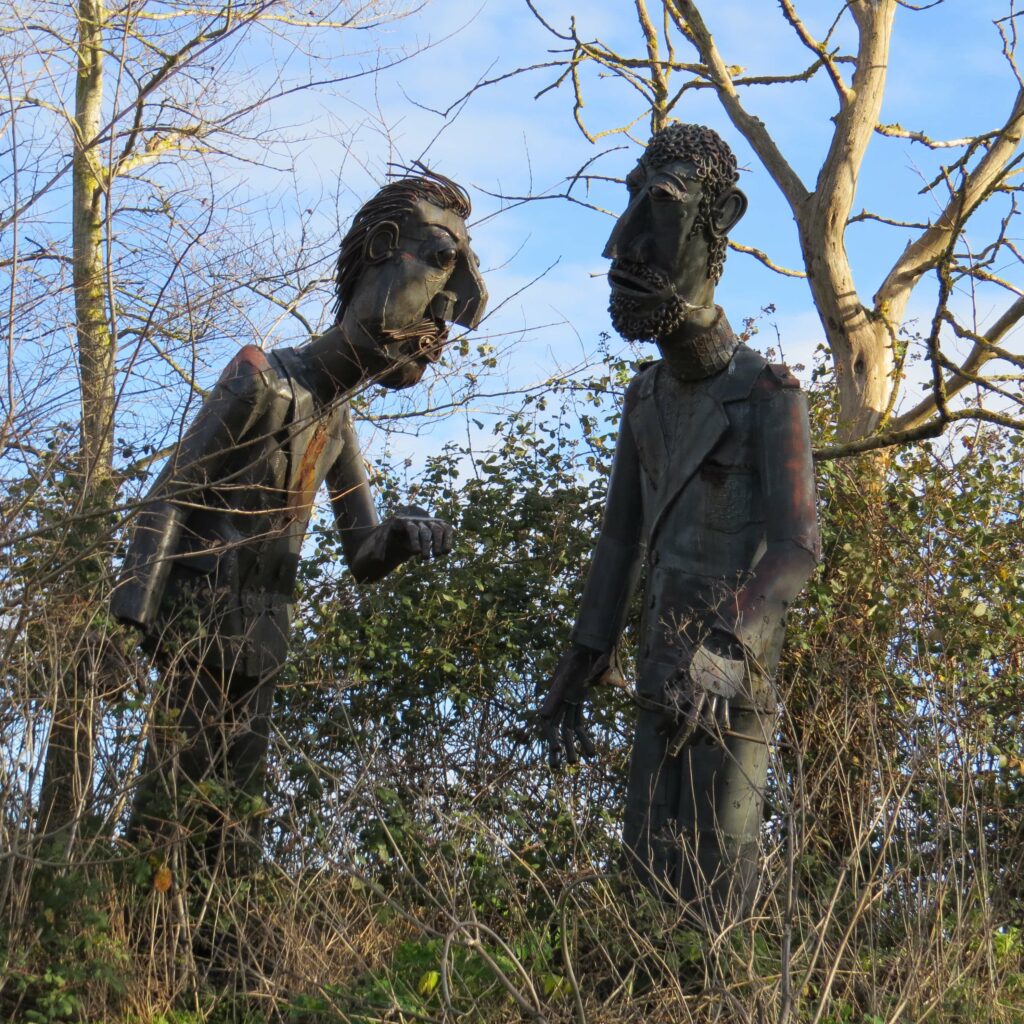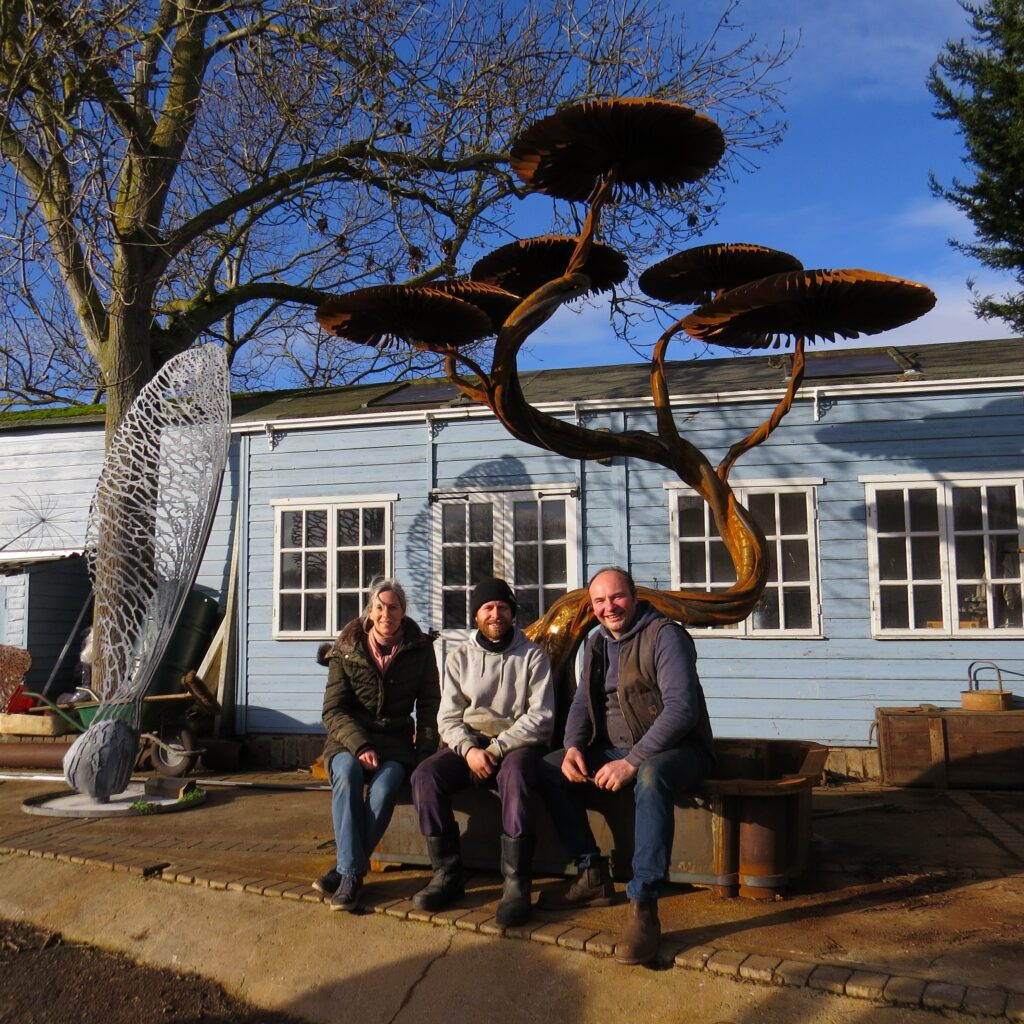Metal Sculptures – beautiful and funny

The best public art makes you think or makes you smile – or even both. It was only recently I realised the witty sculpture on the roof of the public toilets on Major’s Corner in Ipswich town centre, which has been there for many years, was of a major swatting a fly! Why had I never made the connection to the street name before?
It clicked that the metal ballroom dancing couples, that I’ve seen hundreds of times at Ipswich Hospital, must have been made by the same artist. Finally, this summer, I popped into Gainsborough Library in Ipswich and saw some similar sculptures – and this time there was a name plate, Paul Richardson… and I had to discover more.
Paul works out of his studio in Middleton in Suffolk, with his artist wife Catherine, at their business ‘Garden Steel Sculptures’ . You can’t miss it. There are metal figures on the roadside!
I found there are two sides to the business – amusing public art that comes from Paul’s quirky sense of humour, and their elegant creations for gardens, inspired by nature. Catherine’s design skills and business acumen, combine with Paul’s vision, and practical skills of cutting, welding, and bending of steel, create a perfect partnership.
“Paul is very dyslexic so I began working on the paperwork side and, in bidding meetings and interviews for public art commissions, I would go along too, as the person who brought some sort of calm!” laughed Catherine. “Saying yes we can keep to a budget and will think about health and safety…” as Paul got carried away with his enthusiasm for his crazy ideas.
Paul studied graphics and did an art degree but gradually his two-dimensional works gained three-dimensions. He was very happy working in a spacious disused factory in Birmingham but when Catherine got a job as art education officer at the Ipswich Museums service, they moved to Suffolk.

I asked Paul about the sculptures I liked so much and found they have amusing names, often chosen by Catherine.
The work on the roof of the toilet block is Major Convenience and Paul laughs when he remembers how the first helmet he made for the major, when he tried it out the roof of his house, it looked so small from the ground that he realised it needed to be bigger … much bigger!
The sculptures of ballroom dancers, Quick Step to Recovery, were created to fill an empty courtyard space between buildings at the Ipswich Hospital, and was paid for by donated money that could only be spent on artwork.
“ I’d gone to the hospital for inspiration and it was the way everyone moved around the hospital, and everything had to flow, just like a dance,” remembered Paul. “I liked the challenge of the dance costumes as well … weaving the embroidery with the weld… so it was about the detail for me, the earrings and the jewellery. I got a friend who was a dancer to come with her dress on and pose for me. I knew nothing about dance -and there was no Strictly in those days!”
“We chatted a lot about whether it should be a serious work, as it’s a hospital and people could die there,” said Catherine. “The more we talked about it the more we thought that the complete opposite was what was needed. Years later, when my daughter was on the paediatric ward, we saw people talking to the dancers, which was astonishing….
“….and we get lovely letters and emails from people thanking us and saying how the dancers took them out of a difficult time,” added Paul.
It turns out that there are more of Paul’s work around than I realised. In my local library at Felixstowe his seagulls cling to the wall, I drive past a marching band on Foxhall Road in Ipswich, and walk past the flute-playing angels with wings made of trombone pipes, on St Peter’s church, now the home of the Ipswich Hospital Band. Paul explains how each site or local community inspire his designs.
“The Foxhall Road housing entrance gates have FoxgroveBand because the Celestial Speaker factory was on the site …and the drum represents their logo.”
Paul’s work can also be seen elsewhere in Ipswich, and in Lowestoft, Great Blakenham, Saxmundham, and Flixton,
Paul and Catherine began to also make elegant garden sculptures as the funding process for public art is long, convoluted, and payment is only made once an artist gets through the tendering process and wins the commission. In the meantime, he or she has spent weeks on application forms, drawings, and creating a maquette (a miniature of the work) without pay.
“We made a private commission for somebody that became very popular, after it went to a show for the charity Art for Cure,” said Catherine. “We’d been doing one-offs so had to change our model of working so that they could be reproduced.”
The garden sculptures proved to be very popular and they now employ an assistant, Charlie Temple.
“We’d both been city people but when we moved to Suffolk we became emersed in nature,” Paul said. “We’d pick things up, such as a skeleton leaf or a sycamore seed, and it was so stunning, so beautiful…. When you make humorous work, you are never sure if you are hitting the right note and other people will also find it funny. From a commercial point-of-view, people may find my public art funny but not necessarily want one in their garden!”
Steel usually appears heavy but the couple worked on designs, developing a collection that shows what else can be done with steel, even cutting it away to look lace-like.
Paul and Catherine design the garden sculptures together over several weeks, then Paul makes it mild steel before it is galvanised to make it weather-proof, and then they age it.
“We use hot-dip galvanising which is done in a tank of melted zinc,” explained Catherine. “We usually send our sculptures to be dipped at British Metal Treatments in Great Yarmouth, but the tree we have just made is so big it is heading to Telford to be dipped in the largest tank in the country.”
Paul and Catherine’s garden sculptures are exhibited annually at the Chelsea and Hampton Court Flower Shows and they have, for this year, created a large steel tree, after requests from customers with more land, who wanted larger sculptures.
Laughingly describing the tree as ‘a giant bonsai’ Paul can’t resist adding his humorous take to something so beautiful… the leaves are inspired by the underside of a mushroom. It will be on their stand (number 232) on Pavilion Way at the Chelsea Flower Show this May.

Does Paul have a favourite sculpture? Immediately he answers that it is above the atrium at Gainsborough Community Library. Created in 2008-9, and called Brainstorm, the five tableaus radiate from a brain, and represent the different subject areas of the books in the library: science and nature, art, sound and music, food, etc and finally, chosen by the residents, reading to your children.
So why is it Paul’s favourite work?
“First it was in a library which, for me with my dyslexia, I find (like other people find hospitals) scary. As a kid I would stand there and think how I had no idea how to access any of this!” Paul explained. “I hadn’t been in a library for years, but I found Gainsborough Library is nothing like I had known. It is a community hub, warm and friendly, and I really enjoyed being there. It even has a café! Also, it was an open brief, so Brainstorm is very much my humour.”
If you go to the library, look up at the tableaus – and spot, lightly drawn on the wall behind, a representation of Mr and Mrs Andrews, the famous painting by Suffolk artist Thomas Gainsborough. Well, it is Gainsborough Community Library after all!
For more details: www.steelsculptures.co.uk
(This article was first published in Suffolk Norfolk Life magazine in March 2023)